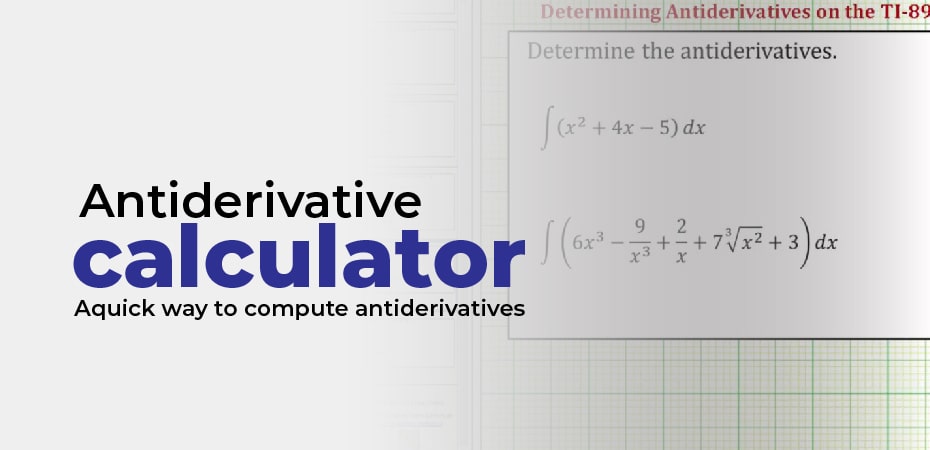The antiderivative calculator calculates the integral value of a function. Integration is the process of finding an antiderivative function. To put it another way, it is the reverse of differentiation. Therefore, the antiderivative is also known as the integral of a function. The antiderivative is the function that converses what the derivative does. One function of the derivative has many antiderivatives, but they take the form of a function including an arbitrary constant. Antiderivative signifies the indefinite integrals in the derivative function.
Before getting into the details to understand the antiderivative concept, we must reinforce the idea of derivatives. So let’s first delve into its definition. As we know,the derivative is the amount of something by which the function changes at the given point in time. In other words, it states the instantaneous rate of change for something. For instance, considering the plane speed, we want to calculate how fast the plane is traveling at a given (t) hour. To determine it, the derivative of time is a handy function while keeping the rate of change in a particular time. So Speed is the derivative of distance concerning time. If you want to count on the plane distance in miles from its departure time at (t) hour, its Speed should be [dy/dt] derivative that expresses Speed in miles per hour.

What is meant by an antiderivative?
Integration is mainly concerned with finding the antiderivative of a function in mathematics. It is the inverse process of differentiation. There can be many antiderivatives of a function, taking the form of a function with the arbitrary constant “C.”
Definition of Antiderivatives
A function of F is the antiderivative of an interval A. IfF’ (x)=f(x) for all x in A.
The opposite form of differentiation isantidifferentiation—the result of antidifferentiation, its antiderivative. You can fairly represent the family of antiderivatives of the function. Add it constantly to a given antiderivative in case of f(x) is the function of antiderivativeF(x). An antiderivative calculator simplifies the computation of your task without erroneous attempts.
The general antiderivative of f(x)=xn
F(X)=[xn+1/n+1]+C x≠1
Where “C” is an Arbitrary Constant.
Let learn to find the General Derivative of the function f(x)=x-3
F(x)=[x-3+1/-3+1]+C
F(x)=[x-2/-2]+C
F(x)=[-1/2x2]+C for x≠0
It is the central part of indefinite integrals. The fundamental theorem of calculus ties together the concepts of differentiating and integrating functions. Generally, you can use the antiderivatives to calculate the area under a curve. For example, ∫ f (x) dx denotes the antiderivative of the function concerning the variable x.
Antidifferentiation Concept
Antidifferentiation is the necessary step to derive the antiderivative function. However, it takes some effort to think in a backward direction to find antiderivatives of the function. Therefore, it is helpful to check for an accurate antiderivative calculation using an antiderivative calculator. Since the derivative is popular before getting the antiderivative of the given function, for that reason, the derivative of the function is taken into consideration to check the given function. The antiderivatives of the function considermany derivative functions, not just one function while making its calculation. The whole family of derivative functions takes the long chain of polynomials as input, including the arbitrary “C” constant.

What is an Antiderivative Calculator?
Integral calculators are online tools that calculate the antiderivative of a function. It works as a definite integral calculator and an indefinite integral calculator and lets you solve the integrated value in no time.
You can use the line integration calculator to evaluate the integrals by following the steps displayed. It integrates a function by parts and solves the integrals using two different methods.
How to Use an Antiderivative Calculator?
You can use simple steps to find the function antiderivative using the antiderivative calculator.
- Go to the antiderivative calculator.
- Enter the function in the antiderivative calculator’s input box.
- You can calculate the antiderivative of the function by clicking its button.
- To clear the fields and enter new values, click the “Reset” button.
How Does the Antiderivative Calculator work?
You can find many integration uses; For example, anyone can use integration to determine the average curve value, the area between two curves, the center of gravity, and the center of mass. Two types of integrals exist in calculus. These are as follows:
Indefinite Integrals – These integrals do not have a limit. As a result, the final value of the integral is indeterminate. When we integrate the derivative of a function, say g'(x), we get the function itself.
Definite Integrals – The integrals that have pre-existing values and defined boundaries are the definite integrals. This integral helps find the area under a curve between two given points (these points serve as limits).
Given below are some properties of integration.
- Differentiating the integral will result in the integrand; ∫ f(x) dx = f(x) + C.
- If two indefinite integrals have the same derivative, then they will be equivalent. As they result in the same family of curves, the two integrals are equivalent; ∫ [ f(x) dx – g(x) dx] =0
- When we perform integration, the variable’s coefficient is taken outside the integral sign; ∫ k f(x) dx = k ∫ f(x) dx.
In order to determine the value of a simple integral, we use the following formula: ∫xn dx = (xn+1 / n+1) + C.
How to Calculate an Antiderivative by Hand
Indefinite integrals and antiderivative calculator compute differently depending on the expression. Therefore, we can apply what is known as “integral rules” for many standard terms, which are essentially shortcuts for determining the antiderivative. The integral rules are applied to expressions similarly to how derivative rules are applied.
If an expression does not have an integral rule, other methods may be employed, which may be more prolonged and tedious. For example, it is possible to integrate too complex phrases to handle by the power rule. The integral of ln(x) is an example of an antiderivative that requires integration by parts.
U-substitution is useful in calculating composite function derivatives as it follows the reversal chain of rule that you can easily compute using an antiderivative calculator. Furthermore, a trig function of a polynomial also helps in derivative determination for composite functions.


